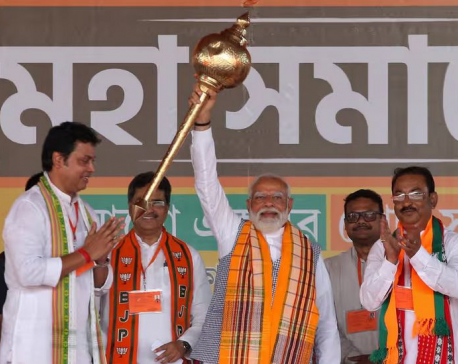
OR
Kathmandu’s roads
There is perhaps not a single media outlet in Kathmandu that has not carried stories on the wretched state of valley roads. Yet despite the overwhelming coverage of this issue in popular media and mounting public pressure for urgent action, little has been done. The concerned authorities have ignored all their concerns, and even the concerns of the parliament on this issue of public interest. Early in July, the parliament’s development committee had instructed the Ministry of Physical Infrastructure and Transport, the Department of Roads and the Kathmandu Metropolitan City (KMC) to rebuild damaged roads in line with international standards within three months. The committee had also pointed out that the valley’s total road length of 1,594 kilometers was nearly not enough to adjust the million vehicles that ply on them every day; and hence the need for more roads. But little is being done to improve roads in Kathmandu. Even major intersections like Ratnapark and Chabahil have deep craters, bang in the middle of the road, as if mini-bombs have gone off there recently. This rainy season, they are filled with water, making motorists misjudge their depth, to great peril of men and machine alike.
Alternately, when these roads are dry, they emit great swirls of dust, reducing visibility, dirtying clothes and resulting in a cornucopia of pulmonary diseases. In its mid-year review of (mainly) air pollution data, numbeo.com, a data-tracking website, ranked Kathmandu as the fifth most polluted city in the world. Even the likes of Beijing and New Delhi, which are often cited in international media for their foul air, do better than Kathmandu in the ranking. In other words, present-day Kathmandu is not a livable city. Some of it can be attributed to the noxious exhaust of the ever-increasing number of vehicles. But the main problem in Kathmandu right now, at least when it does not rain, is dust. It is everywhere. Yet even bare minimum has not been done to control Kathmandu’s air pollution. For instance, the ubiquitous eddies of dust seen on valley roads could have been avoided with better coordination on road-works between the Department of Roads and the Kathmandu Upatyaka Khanepani Limited (KUKL). Yet instead of working together to minimize damage to roads, they often seem to be working at cross-purposes.
The dust pollution could also have been minimized with timely completion of the KUKL’s seemingly interminable Melamchi water project. But given the pathetic state of its roads, which are currently its only means of transport, Kathmandu is unworthy of being called a metropolis. The government seems to believe that a city of certain population size and area ipso facto becomes a metropolis. But that is not the case. Even a poorly managed metropolis like Pakistan’s Multan, with its heaps of uncollected roadside garbage, these days has far better roads and transport systems, including a Bus Rapid Transit, than Kathmandu. It has a cleaner air, too. Air pollution is something that is literally killing the inhabitants of Kathmandu valley, the rulers and the ruled alike—and today, not in some distant future. Are our politicians and bureaucrats so fatalistic that they have stopped caring for their own health?
You May Like This

Fixing a win by outlawing dissent damages democracy
The world’s largest elections begin this weekend in India, amid claims that the race to lead the country has already... Read More...

Rain shocks: On the monsoon in 2024
The India Meteorological Department (IMD) has forecast a bountiful monsoon. Rainfall from June-September is expected to be 6% more than... Read More...

Nagdhunga-Sisnekhola tunnel breakthrough: Beginning of a new era in Nepal’s development endeavors
The breakthrough of the Nagdhunga-Sisnekhola tunnel marks a significant leap forward in Nepal's development. For Nepalis who have only traveled... Read More...

Just In
- Indians vote in the first phase of the world’s largest election as Modi seeks a third term
- Kushal Dixit selected for London Marathon
- Nepal faces Hong Kong today for ACC Emerging Teams Asia Cup
- 286 new industries registered in Nepal in first nine months of current FY, attracting Rs 165 billion investment
- UML's National Convention Representatives Council meeting today
- Gandaki Province CM assigns ministerial portfolios to Hari Bahadur Chuman and Deepak Manange
- 352 climbers obtain permits to ascend Mount Everest this season
- 16 candidates shortlisted for CEO position at Nepal Tourism Board







_20220508065243.jpg)










Leave A Comment